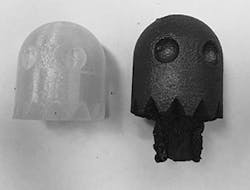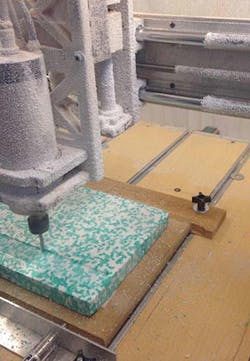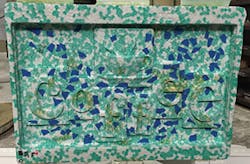Who knows, one day we may look back on the emergence of additive manufacturing (i.e., 3D printing) as first step in a metalcasting renaissance. That may not be a typical outlook among dedicated metalcasters, who rightly recognize 3DP’s edge over casting processes in terms of converting designs into structures. Basically, it avoids the time and effort of developing a mold. But, to compare their results, additive manufacturing is not obviously better than metalcasting.
“Adding up layer upon layer of metal is time consuming and costly,” explained Sarah Jordan. “Generally it does not give you the same properties as traditional manufacturing. If you use it for prototypes, that is a problem if you hope to be able to compare actual use as opposed to just form and fit.”
An example of a shape produced first by 3DP and then recreated as a steel casting, in an example of “transitive manufacturing.”
This is just one limitation for AM, according to Jordan, who is a co-owner of Skuld LLC, a company started last year with some metalcasting experience and distinct vision for a more practical application of AM techniques.
Jordan’s partner is Mark DeBruin, and both are proponents of lost-foam casting — the well-established process that uses patterns made of polystyrene to achieve exceptional design detail. When molten metal is poured into the mold it volatizes and then evaporates the foam, while a part is formed in the detailed shape it had defined.
Jordan and DeBruin had lost-foam expertise as partners in Aesir Metals LLC, a foundry that produced ductile iron and even stainless steel parts, but which struggled and failed to secure sufficient business during the Great Recession. It could not have helped that during that time investors were being smitten with the novelty of AM/3DP, and the promise of customized manufacturing of detailed parts straight from CAD.
They pursued other projects after Aesir Metals closed, but were drawn back to metalcasting by a National Additive Manufacturing Innovation Institute competition to identify promising new businesses.
“We entered it with the idea of evaporative casting 3D printing polymers,” Jordan said. “At that point our technology was untested but with our experience in lost-foam casting it seemed that it should work.”
Skuld— the name refers to one of the fates in Norse mythology, one that controls the future —is applying its lost-foam (or evaporative casting) expertise in several ways, but also incorporating AM/3DP insights. Products are designed in CAD, printed as low-density PLA (biodegradeable polylactic acid) foam shapes, and then cast in gray or ductile iron, standard or low carbon steel, stainless steel, or nonferrous alloy.
A pattern is machined in foam in preparation for evaporative casting.
“There are inherent limitations of 3D printing for metal,” Jordan noted, “because you are essentially blowing up molten metal into powder, and then trying to reweld it back together. It’s not surprising that the mechanical properties are weaker, that they have corrosion problems, and that 3D-printed metals generally just aren’t comparable to (parts produced by) traditional manufacturing.
“It seems clear to us that to overcome this in a cost-effective way means getting away from 3D printing of metal,” she continued. “3D printing of core sand is not cost-competitive and it is limited to the tolerances that are achievable in no-bake or green sand casting. The way to improve this, and make to 3D printing a feasible process for metal that obtains current properties is to evaporative cast the 3D printed shape.”
As outlined in Skuld’s business plan, “by vaporizing the 3D printed material and instantly replacing it with the metal alloy of your choice, you obtain the same geometry but solve the problem of undesirable microstructures, inconsistent properties, and the need to continually develop 3D printing materials.”
While Jordan allowed that the initial process trials resulted in some explosions and unfilled parts (“due to the gas pressure”), Skuld now has defined the right process parameters for evaporative casting with the 3DP materials, and recently applied for a patent.
Arising from Evaporative Casting
From this, the business offers three types of products, all of them linked to evaporative casting. First are thin-wall ductile iron castings, a category with much commercial promise, for example, in reducing weight and mass in automotive engine and powertrain parts.
Another area of application is evaporative casting of stainless steel, which had been one of the particular accomplishments for DeBruin and Aesir Metals. Custom-designed castings may be offered for chemical processing, or in applications here corrosion-resistance may be necessary.
The third application for Skuld’s evaporative casting approach involves parts Carbidic Outer Edge Ductile Iron casting, a process for which DeBruin holds a patent, wherein a carbide-inducing coating is placed on the surface of the foam before the lost-foam process begins. The cast part has hard carbide at selected locations on the surface, but with ductile iron elsewhere and at its core.
The foam pattern, finished and ready for evaporative casting.
Skuld LLC is focused now on producing sample castings as a way to win larger orders. “Unfortunately, there are so few true lost foam iron foundries in the United States that you have to convert all jobs from some other process,” Jordan explained. This means that parts have to be redesigned in order to achieve the cost-saving advantages intended by lost-foam’s improved tolerances, as well as by reducing or eliminating machining. “We are willing to do this for parts in other foundry processes,” she said, “or by converting those that use other processes entirely, such as weldments.”
It follows that Skuld is looking for casting buyers that want to save the time and cost of machining and/or welding parts, including parts for industrial or agricultural machinery.
Jordan confirmed that Skuld intends to establish its own foundry, but having taken that approach with Aesir Metals it intends to build a customer base first. It is sourcing business and producing the castings in partnership with other foundries willing to share some excess capacity.
One partner is Ende Machine and Foundry, Craigmont, ID, one of just few non-captive lost-foam foundries for ferrous parts. The two companies have undertaken more than one casting project in the past year, producing ductile iron parts with section sizes as thin as 0.070 in. More recently, they are producing high-phosphorous iron lost-foam castings for aircraft piston rings. The first-article pieces are being tested by a defense contractor.
Skuld has developed projects with other foundries too, and while it has a licensing arrangement with Ende Jordan indicated they are available for similar opportunities with other metalcasters.
The broader message from Skuld LLC is that “additive manufacturing” is a valid technique to support existing metalcasting process, but not to replace it.
“Additive manufacturing is a broad term to indicate that material is added up in layers to get a desired shape,” Sarah Jordan commented, but adding that the definition may also be understood as direct challenge to “subtractive” manufacturing, i.e. machining. To pursue that mathematical analogy, she proposed that most metalcasting is “reflective”: Solidified metal takes a shape that reflects the mold.
And so, to continue the analogy, lost-foam and evaporative casting of 3DP forms is “transitive manufacturing.”
“As you may recall from math, the transitive property says ‘If A=B and B=C, then A=C’: You start with a drawing, which then is used to make the form to be cast; this is then replaced with molten metal that solidifies within the mold. The resulting shape is essentially the same, meaning this process is transitive.”
In short, the terms used to describe a manufacturing process do not qualify the results in any objective way, and the practical limitations of AM/3DP have been identified. Layering metals is time-consuming and can be expensive, and parts have to be “overdesigned” in order to address structural weakness. There also are limits the number of metal alloys available for AM/3DP.
“3D-printing of resin bonded molds has been started a way to address these issues,” Jordan allowed, though the process still does not achieve tolerances comparable to evaporative casting.
“No bake tolerances are typically +/- 0.020 in./in.,” she noted, “whereas evaporative casting is ten times better at +/-0.003 in./in. That means that even if you 3D-print a mold and cast it, you will usually need to do lots of additional machining on it.
“3D-printing of a pattern in order to then evaporative cast it may not be the best choice for all designs: It can be easier in some cases to machine foam stock and glue several pieces together to then evaporative cast it.
“At the end of the day what is most competitive will be those processes that are fast, flexible in what they can be used to design, deliver the necessary material properties, and reduce total costs of manufacturing,” she concluded.
About the Author
Robert Brooks
Content Director
Robert Brooks has been a business-to-business reporter, writer, editor, and columnist for more than 20 years, specializing in the primary metal and basic manufacturing industries. His work has covered a wide range of topics, including process technology, resource development, material selection, product design, workforce development, and industrial market strategies, among others.



